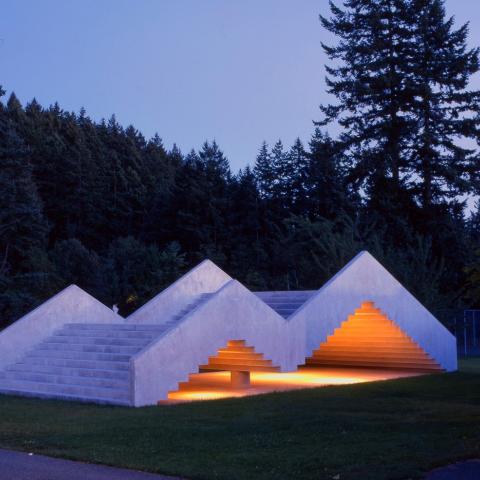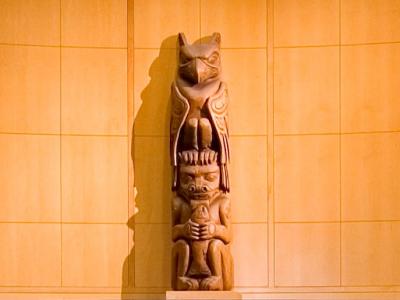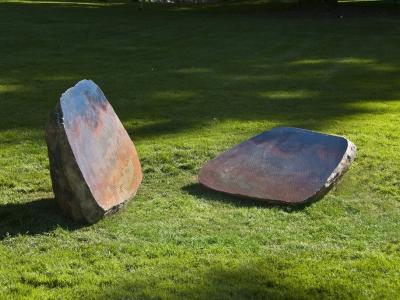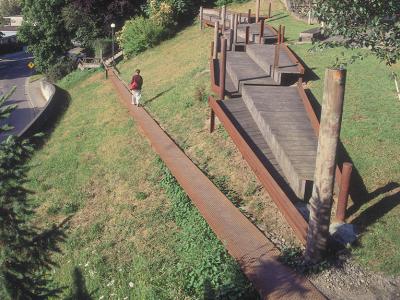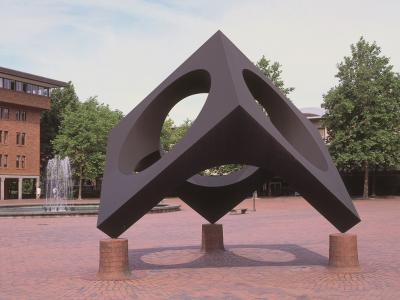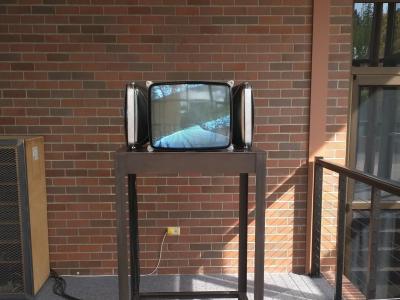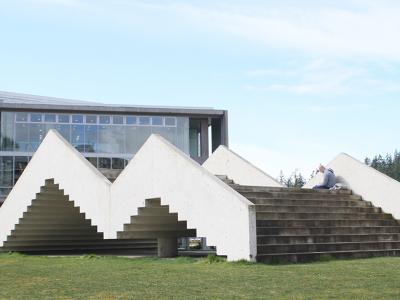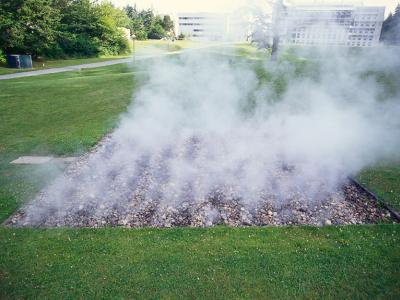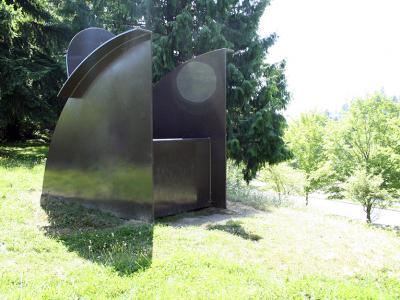Bruce Nauman, Stadium Piece, 1998-99
Bruce Nauman, 1998-99.
Concrete, tinted white. 13' h. x 25' w. x 50' l.
Photo credit: Manuel R. del Pozo
Gift of the Virginia Wright Fund. © Bruce Nauman/Artist Rights Society (ARS), New York.
Description
Walk around the sculpture with Google Street View
Similar to Holt and Morris, Bruce Nauman has created work that dramatically breaks down the barrier that had kept the viewer on the outside of an object. Just as Morris did, he has given the spectator a new role as contributor of meaning. Rather than offering a plaque as Scott did, Nauman elaborates on the idea of spectacle. He creates sculptural situations for the onlooker so that spectatorship requires a deeper commitment. What we expect based on other experience can become unsettling.
In thinking about what he might propose for Western's campus, Nauman became intrigued with the area of campus south of the steps between Parks Hall (College of Business, housing business and speech pathology) and the Environmental Studies building. Perhaps, this major staircase triggered the notion that this was the public's ''front door'' to the University or that this standard, cultural idea of front stairs could be further examined in a more individual way. Earlier, at his own university, he had concentrated on math, physics, music, and philosophy. Later, when he began to make his own art, he found a type of inclusive methodology in this rigorous background and parallels among the disciplines.
Full text
For example, in both math and physics there were examples where reason was contradictory or broken in a supposedly logical field. He liked the composer Arnold Schoenberg's use of variations in a structure as a means of timing. He appreciated the philosopher Ludwig Wittgenstein's ability to follow an idea to conclusion and his habit of including contradictory arguments in the finished thesis. He also admired his systematic process, which often included taking a step back ward or also offering failed statements; and he liked his games, which allowed him to ''find out what I was doing, how I was doing it." In Samuel Beckett's character Malloy he also found similar traits where the most ordinary, mundane human activities became important.''
Perhaps, the ''front door'' steps prompted him to remember earlier works or questions that could be freshly addressed in a university setting. For example, there is the story of the Original Slant Step (1965-66): When visiting a salvage shop, Nauman had noticed a strange wood and linoleum step that seemed to have the function of allowing shopkeepers to sit and/or to reach high places. When he closely examined it, he saw that it was actually functionless because of the degree of the slant of the step. He bargained for the slanted step because it exemplified the problems he was trying to solve in his studio. One was making art objects that appear to have a function, and another was to follow a philosophical principle that requires looking at things without preconceived notions. Nauman was interested in creating works that made the viewer think about what he knows and does not know, what he sees and does not see. Most importantly, he wanted to invite the viewer to take a step or to become performer.
At Western the ''front door'' steps are opposite the playing fields for students. Ironically, Western does not have an official stadium. While the University is strong in various competitive sports, students also enjoy the fields for exercises in theater, t'ai chi, Frisbee, and dog runs. When Nauman began to plan his work for Western, he knew the open fields would in the future become a new quadrangle including a Communications building, another academic building, and a multi-recreational building joining the existing field track. So Nauman created Stadium Piece (1998-99), a structure appearing to be a series of steps but also having the qualities of a stadium or a theater. The activity in a stadium or open theater takes place on the field; spectators on bleachers watch the activity below. Nauman liked the normal idea that students would use these steps as seats to watch the playgrounds or pedestrian and/or vehicular traffic. But he also knew that ordinary notions can be inverted. Therefore, he turned his stadium-like or theatrical structure upside-down and invited the stationary viewer to perform on and across a stepped structure that becomes a new type of playing field where everyone can participate. Playing on the variations of what is up or down, Nauman permits the spectators to face inward to each other or look at something-,or nothing-on the way up or down and outward. While the steps can look ordinary, as something to bypass, the viewer himself has to make the decision whether to climb. The body remembers how to climb stairs but is suddenly forced to concentrate, and go more slowly as the normal ratio of risers to threads has been slightly changed.'' Similar to the experience of facing a crowd or being alone, the climber discovers he is moving between private and public spaces. He pushes himself to the top where everyone can see him, then goes down, sinks quickly, almost out of sight to others, to his own private interior.
While on the exterior of the steps, our usual body movements can become slightly dislocated or accentuated. Raised on piers, the stepped structure also provides a lighted interior space that evokes the idea of spectacles on the one hand, or concealed movement on the other. It triggers our memories of all types of stadiums -- the rules of the game--processional marches--or makes us think of underhanded and underground activities in cages. But where we are often in competition with each other, the light can shine. At night or twilight when the lights are on underneath the concrete structure, tinted white, the entire stepped shape echoes the snowcapped mountain ranges in the distance. Nauman's Stadium Piece embodies the student's learning to communicate individually or how to perform in a larger cultural memory or environment.
© Sarah Clark-Langager


